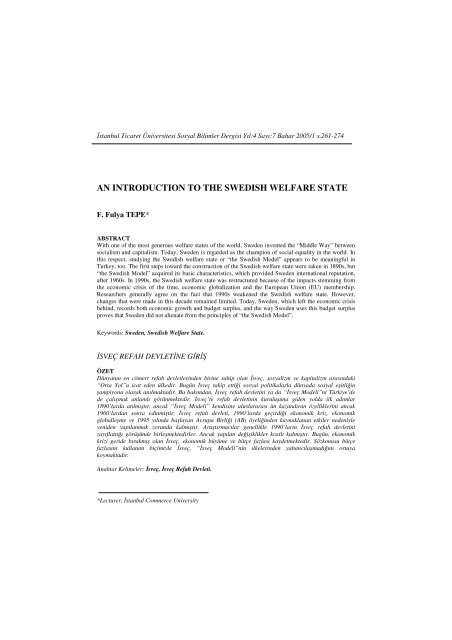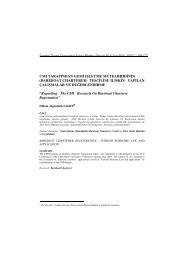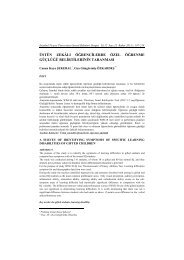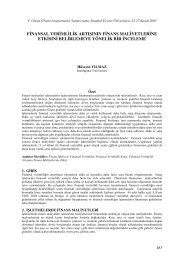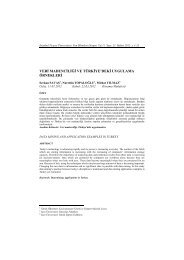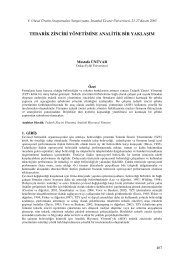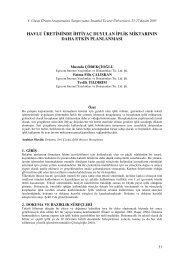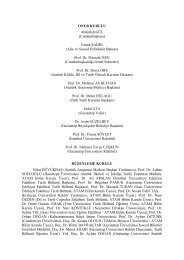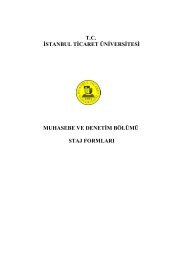an introduction to the swedish welfare state - Ä°stanbul Ticaret ...
an introduction to the swedish welfare state - Ä°stanbul Ticaret ...
an introduction to the swedish welfare state - Ä°stanbul Ticaret ...
You also want an ePaper? Increase the reach of your titles
YUMPU automatically turns print PDFs into web optimized ePapers that Google loves.
İst<strong>an</strong>bul <strong>Ticaret</strong> Üniversitesi Sosyal Bilimler Dergisi Yıl:4 Sayı:7 Bahar 2005/1 s.261-274AN INTRODUCTION TO THE SWEDISH WELFARE STATEF. Fulya TEPE*ABSTRACTWith one of <strong>the</strong> most generous <strong>welfare</strong> <strong>state</strong>s of <strong>the</strong> world, Sweden invented <strong>the</strong> “Middle Way” betweensocialism <strong>an</strong>d capitalism. Today, Sweden is regarded as <strong>the</strong> champion of social equality in <strong>the</strong> world. Inthis respect, studying <strong>the</strong> Swedish <strong>welfare</strong> <strong>state</strong> or “<strong>the</strong> Swedish Model” appears <strong>to</strong> be me<strong>an</strong>ingful inTurkey, <strong>to</strong>o. The first steps <strong>to</strong>ward <strong>the</strong> construction of <strong>the</strong> Swedish <strong>welfare</strong> <strong>state</strong> were taken in 1890s, but“<strong>the</strong> Swedish Model” acquired its basic characteristics, which provided Sweden international reputation,after 1960s. In 1990s, <strong>the</strong> Swedish <strong>welfare</strong> <strong>state</strong> was restructured because of <strong>the</strong> impacts stemming from<strong>the</strong> economic crisis of <strong>the</strong> time, economic globalization <strong>an</strong>d <strong>the</strong> Europe<strong>an</strong> Union (EU) membership.Researchers generally agree on <strong>the</strong> fact that 1990s weakened <strong>the</strong> Swedish <strong>welfare</strong> <strong>state</strong>. However,ch<strong>an</strong>ges that were made in this decade remained limited. Today, Sweden, which left <strong>the</strong> economic crisisbehind, records both economic growth <strong>an</strong>d budget surplus, <strong>an</strong>d <strong>the</strong> way Sweden uses this budget surplusproves that Sweden did not alienate from <strong>the</strong> principles of “<strong>the</strong> Swedish Model”.Keywords: Sweden, Swedish Welfare State.İSVEÇ REFAH DEVLETİNE GİRİŞÖZETDüny<strong>an</strong>ın en cömert refah devletlerinden birine sahip ol<strong>an</strong> İsveç, sosyalizm ve kapitalizm arasındaki“Orta Yol”u icat eden ülkedir. Bugün İsveç takip ettiği sosyal politikalarla dünyada sosyal eşitliğinşampiyonu olarak <strong>an</strong>ılmaktadır. Bu bakımd<strong>an</strong>, İsveç refah devletini ya da “İsveç Modeli”ni Türkiye’dede çalışmak <strong>an</strong>lamlı görünmektedir. İsveç’te refah devletinin kuruluşuna giden yolda ilk adımlar1890’larda atılmıştır, <strong>an</strong>cak “İsveç Modeli” kendisine uluslararası ün kaz<strong>an</strong>dır<strong>an</strong> özelliklerini <strong>an</strong>cak1960’lard<strong>an</strong> sonra edinmiştir. İsveç refah devleti, 1990’larda geçirdiği ekonomik kriz, ekonomikgloballeşme ve 1995 yılında başlay<strong>an</strong> Avrupa Birliği (AB) üyeliğinden kaynakl<strong>an</strong><strong>an</strong> etkiler nedeniyleyeniden yapıl<strong>an</strong>mak zorunda kalmıştır. Araştırmacılar genellikle 1990’ların İsveç refah devletinizayıflattığı görüşünde birleşmektedirler. Ancak yapıl<strong>an</strong> değişiklikler kısıtlı kalmıştır. Bugün, ekonomikkrizi geride bırakmış ol<strong>an</strong> İsveç, ekonomik büyüme ve bütçe fazlası kaydetmektedir. Sözkonusu bütçefazlasını kull<strong>an</strong>ım biçimiyle İsveç, “İsveç Modeli”nin ilkelerinden yab<strong>an</strong>cılaşmadığını ortayakoymaktadır.Anahtar Kelimeler: İsveç, İsveç Refah Devleti.*Lecturer, İst<strong>an</strong>bul Commerce University
F. Fulya Tepe1. IntroductionRecent scholarship on <strong>welfare</strong> <strong>state</strong>s deals with durability or sustainability of <strong>the</strong><strong>welfare</strong> <strong>state</strong>s in <strong>the</strong> face of globalization. However, this paper, risking <strong>to</strong> beoutmoded <strong>an</strong>d unoriginal, will focus on <strong>the</strong> Swedish <strong>welfare</strong> <strong>state</strong> which is <strong>the</strong>epi<strong>to</strong>me of <strong>the</strong> social democratic <strong>welfare</strong> <strong>state</strong> regime. The Swedish <strong>welfare</strong> <strong>state</strong>,being one of <strong>the</strong> most adv<strong>an</strong>ced <strong>welfare</strong> <strong>state</strong>s of <strong>the</strong> world, provides a model interms of extensiveness of social policies that a <strong>state</strong> could offer <strong>to</strong> its citizens. In thisrespect, considering that most of <strong>the</strong> Turkish readers are not familiar with <strong>the</strong> <strong>to</strong>pic,<strong>the</strong> main objective of this paper will be <strong>to</strong> give a brief but representative account of“<strong>the</strong> Swedish Model”. By “<strong>the</strong> Swedish Model”, it is generally me<strong>an</strong>ta mixed market economy in which <strong>the</strong> division of responsibility between private enterprise <strong>an</strong>d <strong>the</strong> publicsec<strong>to</strong>r in <strong>the</strong> economic sphere, <strong>an</strong>d between org<strong>an</strong>izations <strong>an</strong>d individuals, is intended <strong>to</strong> secure a fair,socially acceptable distribution of income <strong>an</strong>d wealth <strong>an</strong>d <strong>the</strong> eradication <strong>an</strong>d absence of poverty withoutjeopardizing economic efficiency <strong>an</strong>d growth in <strong>the</strong> long run. (Gylfason & o<strong>the</strong>rs, 1997: 13)I will use <strong>the</strong> <strong>the</strong>me of <strong>welfare</strong> <strong>state</strong>s under <strong>the</strong> impact of globalization, <strong>to</strong>o <strong>an</strong>d giveit a place in <strong>the</strong> end of <strong>the</strong> paper.To begin with, I should note that <strong>the</strong> idea of <strong>welfare</strong> <strong>state</strong> is thought <strong>to</strong>ge<strong>the</strong>r withnation-<strong>state</strong>s. In o<strong>the</strong>r words, <strong>the</strong> <strong>welfare</strong> <strong>state</strong> is considered <strong>to</strong> be a project ofcapitalist nation-<strong>state</strong>s, which dates back <strong>to</strong> <strong>the</strong> 19 th <strong>an</strong>d early 20 th centuries(Leisering, 2003: 175). Germ<strong>an</strong>y is regarded as <strong>the</strong> pioneer in <strong>the</strong> <strong>welfare</strong> <strong>state</strong>politics with Bismarck’s social insur<strong>an</strong>ce designed <strong>to</strong> meet <strong>the</strong> needs of <strong>the</strong>industrial workers of <strong>the</strong> time (Leisering, 2003: 177, 182).It may also be useful <strong>to</strong> give some basic information on Sweden, in <strong>the</strong> <strong>introduction</strong>of <strong>the</strong> article, with a focus on <strong>the</strong> 20th century: Sweden did not enter <strong>the</strong> First <strong>an</strong>d<strong>the</strong> Second World Wars, pursuing a policy of neutrality in foreign affairs. So thatwhile o<strong>the</strong>r Europe<strong>an</strong> nations were trying <strong>to</strong> reconstruct <strong>the</strong>ir countries after <strong>the</strong>World Wars, Sweden could have a different <strong>an</strong>d better agenda at <strong>the</strong> time. In 1936,with Childs’ famous book titled “Sweden: The Middle Way”, <strong>the</strong> Swedish way wasdescribed as a third option between socialism <strong>an</strong>d capitalism. 1960s were <strong>the</strong> goldenage of <strong>the</strong> Swedish <strong>welfare</strong> <strong>state</strong> which is a matter of national pride <strong>an</strong>d identity for<strong>the</strong> Swedes. In 1970s, it became <strong>the</strong> third richest country in <strong>the</strong> world. 1980s <strong>an</strong>d1990s were years of economic crisis for Sweden. Under <strong>the</strong> pressure of economicproblems, Sweden joined <strong>the</strong> EU in 1995. Sweden is one of <strong>the</strong> leaders of genderequality in <strong>the</strong> world: One half of <strong>the</strong> cabinet <strong>an</strong>d 40 per cent of <strong>the</strong> Riksdag (<strong>the</strong>Swedish Parliament) are women (Gould, 1999: 169). In 1996, only 3 per cent of <strong>the</strong>262
Bahar 2005/1whole Swedish population was working in <strong>the</strong> agriculture sec<strong>to</strong>r (Swedish Institute[SI], 2003 / a; 3). So that <strong>to</strong>day’s Swedish society with its approximately 9 millionmembers, is a post-industrial society. According <strong>to</strong> <strong>the</strong> 2003 Information SocietyIndex, Sweden is <strong>the</strong> world’s leading information technology country <strong>an</strong>d has keptthis position for <strong>the</strong> last four years (SI, 2003 / b: 1). In 2004, <strong>the</strong> United NationsDevelopment Programme (UNDP) r<strong>an</strong>ked Sweden <strong>the</strong> second best country in termsof average levels of education, income <strong>an</strong>d expected length of lifetime.2. Variations Among Welfare StatesThe D<strong>an</strong>ish sociologist Gøsta Esping-Andersen’s work, “Three Worlds of WelfareCapitalism”, is one of <strong>the</strong> most influential contributions <strong>to</strong> <strong>the</strong> <strong>welfare</strong> <strong>state</strong>literature. In order <strong>to</strong> underst<strong>an</strong>d <strong>the</strong> place of Swedish <strong>welfare</strong> <strong>state</strong> in comparison <strong>to</strong>o<strong>the</strong>r <strong>welfare</strong> <strong>state</strong>s, we will follow Esping-Andersen. Based on comparativeemprical research, Esping-Andersen has defined three types of <strong>welfare</strong>-<strong>state</strong>regimes: liberal <strong>welfare</strong> <strong>state</strong>s, conservative-corporatist <strong>welfare</strong> <strong>state</strong>s <strong>an</strong>d socialdemocratic <strong>welfare</strong> <strong>state</strong>s. The first category involves countries like United States,C<strong>an</strong>ada, Australia <strong>an</strong>d offers ‘me<strong>an</strong>s-tested assist<strong>an</strong>ce, modest universal tr<strong>an</strong>sfers, ormodest social-insur<strong>an</strong>ce pl<strong>an</strong>s’ (Esping-Andersen, 1990: 26) which target mainly <strong>the</strong>working class. This model, in which <strong>the</strong> <strong>state</strong> promotes <strong>the</strong> market,minimizes de-commodification-effects, effectively contains <strong>the</strong> realm of social rights, <strong>an</strong>d erects <strong>an</strong> orderof stratification that is a blend of a relative equality of poverty among <strong>state</strong>-<strong>welfare</strong> recipients, marketdifferentiated<strong>welfare</strong> among <strong>the</strong> majorities, <strong>an</strong>d a class-political dualism between <strong>the</strong> two. (Esping-Andersen, 1990: 27)The second category which is labeled as conservative-corporatist c<strong>an</strong> be exemplifiedwith continental Europe<strong>an</strong> countries such as Austria, Fr<strong>an</strong>ce, Germ<strong>an</strong>y <strong>an</strong>d Italy.The conservative-corporatist model is characterized with its insistence onmaintaining status differences among its citizens; this me<strong>an</strong>s that social rights aretied <strong>to</strong> status <strong>an</strong>d class <strong>an</strong>d <strong>the</strong> redistributive function of <strong>the</strong> <strong>state</strong> remainunderdeveloped (Esping-Andersen, 1990: 27). Being influenced by <strong>the</strong> Church, thismodel isstrongly committed <strong>to</strong> <strong>the</strong> preservation of <strong>the</strong> traditional familyhood. Social insur<strong>an</strong>ce typically excludesnon-working wives, <strong>an</strong>d family benefits encourage mo<strong>the</strong>rhood. Day care, <strong>an</strong>d similar family services,are conspicuously underdeveloped; <strong>the</strong> principle of ‘subsidiarity’ serves <strong>to</strong> emphasize that <strong>the</strong> <strong>state</strong> willonly interfere when <strong>the</strong> family’s capacity <strong>to</strong> service its members is exhausted. (Esping-Andersen,1990: 27)263
F. Fulya TepeAnd <strong>the</strong> third category which is called <strong>the</strong> social democratic <strong>welfare</strong> regimerepresents <strong>the</strong> Sc<strong>an</strong>dinavi<strong>an</strong> countries. This model is based on <strong>the</strong> principles ofuniversalism <strong>an</strong>d de-commodification <strong>an</strong>d aims <strong>to</strong> provide services of highestst<strong>an</strong>dards <strong>to</strong> its citizens equally. (Esping-Andersen, 1990: 27). Ensuring same rightsfor blue-collar <strong>an</strong>d white-collar employees, one universal insur<strong>an</strong>ce system worksfor all in accord<strong>an</strong>ce with earnings. In terms of family policy, this model takespreventive measures <strong>to</strong> render <strong>the</strong> costs of family life in<strong>to</strong> a social matter <strong>an</strong>dencourages independence from family (Esping-Andersen, 1990: 28). Esping-Andersen describes this model, in which <strong>state</strong> services are also offered <strong>to</strong> <strong>the</strong>children, <strong>the</strong> old people <strong>an</strong>d <strong>the</strong> helpless, as ‘a peculiar fusion of liberalism <strong>an</strong>dsocialism’ (Esping-Andersen, 1990: 28).Esping-Andersen explains this variation in <strong>welfare</strong> regimes with three fac<strong>to</strong>rs thatare considered <strong>to</strong> weigh most: ‘<strong>the</strong> nature of class mobilization (especially of <strong>the</strong>working class); class-political coalition structures; <strong>an</strong>d <strong>the</strong> his<strong>to</strong>rical legacy ofregime institutionalization’ (Esping-Andersen, 1990: 29). Although thiscategorization of <strong>welfare</strong> regimes, which is based on comparative emprical data, is<strong>an</strong> import<strong>an</strong>t contribution <strong>to</strong> <strong>the</strong> literature, Esping-Andersen adds that <strong>the</strong>se regimetypes are not pure categories. Each regime type may involve elements from o<strong>the</strong>rregime types (Esping-Andersen, 1990: 28).3. The Construction of <strong>the</strong> Swedish Welfare StateThe Swedish industrialization started relatively late in 19 th century but developedra<strong>the</strong>r rapidly. The ensuing social problems, especially those connected with povertycarried Sweden in<strong>to</strong> a discussion of social policies in 1880s <strong>an</strong>d it is accepted that<strong>the</strong>se discussions are greatly indebted <strong>to</strong> Bismarck’s social policies in Germ<strong>an</strong>y(Lundberg & Åmark, 2001: 157). Since <strong>the</strong>n, Sweden has gradually improved itssocial insur<strong>an</strong>ce system: The first step in this direction was taken in 1891 when <strong>the</strong>Swedish <strong>state</strong> beg<strong>an</strong> <strong>to</strong> make contributions <strong>to</strong> voluntary sickness insur<strong>an</strong>ce schemes.In 1901, occupational accident insur<strong>an</strong>ce was launched. O<strong>the</strong>r major steps <strong>to</strong>ward<strong>the</strong> construction of <strong>the</strong> Swedish <strong>welfare</strong> <strong>state</strong> included <strong>the</strong> <strong>introduction</strong> of a general,compulsory pension system in 1913 <strong>an</strong>d of a needs-tested local unemploymentbenefits <strong>an</strong>d relief work system, supported by <strong>the</strong> <strong>state</strong>, in 1914 (SI, 2004: 1;Lundberg & Åmark, 2001: 158-159). However, <strong>to</strong>day’s Swedish <strong>welfare</strong> <strong>state</strong> withits ‘[c]itizenship-based <strong>an</strong>d tax-fin<strong>an</strong>ced flat-rate benefits, universally availablesocial <strong>an</strong>d health services, <strong>an</strong>d earnings-related schemes that cover <strong>the</strong> entireworking population’ (Timonen, 2001: 29) was constructed only after <strong>the</strong> SecondWorld War in 1960s. However, Esping-Andersen <strong>state</strong>s that <strong>the</strong> true Swedish model‘came in<strong>to</strong> being with <strong>the</strong> shift <strong>to</strong>wards active labour market policies, social service264
Bahar 2005/1exp<strong>an</strong>sion, <strong>an</strong>d gender equalization in <strong>the</strong> 1970s <strong>an</strong>d 1980s’ (Esping-Andersen,1996: 11). The Swedish <strong>welfare</strong> <strong>state</strong> has <strong>an</strong> international reputation for itsgenerousity <strong>an</strong>d <strong>the</strong> world’s heaviest tax obligations that it poses on its citizens(Wittrock, 2004: 52).As noted by Esping-Andersen, ‘[t]he Swedish <strong>welfare</strong> <strong>state</strong> is based on <strong>the</strong> principlethat <strong>the</strong> <strong>welfare</strong> of <strong>the</strong> individual is <strong>the</strong> responsibility of <strong>the</strong> social collective’(Aspalter, 2002: 9). Within this context, <strong>the</strong> Swedish citizen has a right <strong>to</strong> publicsocial <strong>welfare</strong>. Distribution of <strong>welfare</strong>, which is fin<strong>an</strong>ced by taxes, is based on <strong>the</strong>principle of equality, not on a needs-based approach (Aspalter, 2002: 9). TheSwedish <strong>welfare</strong> model is regarded as <strong>the</strong> basis of Swedish modernity <strong>an</strong>d it enjoysfirm support from Swedish citizens. Moreover, it is a well-known fact that in <strong>the</strong>elections, <strong>the</strong> Swedish citizens punish <strong>the</strong> governments which launch <strong>welfare</strong>cutbacks.The engineers of “<strong>the</strong> Swedish Model” were <strong>the</strong> Social Democracts who ‘firstentered government in a coalition government with <strong>the</strong> Liberals in 1917, <strong>an</strong>d <strong>the</strong>nbecame sole governing party in 1920, in 1921-3 <strong>an</strong>d in 1924-6’ (Wittrock, 2004:52). About <strong>the</strong> place of social democracy in Sweden, Wittrock <strong>state</strong>s that[i]t is no exaggeration <strong>to</strong> say that <strong>the</strong> Swedish political scene has been dominated by social democracy for<strong>the</strong> past 86 years. At least since <strong>the</strong> mid-1940s this domin<strong>an</strong>ce has involved <strong>an</strong> ideological hegemony.From at least <strong>the</strong> mid-1960s, <strong>the</strong> Social Democrats have also enjoyed what might be termed a socialhegemony in <strong>the</strong> sense that <strong>the</strong> party does not only represent large parts of society, it has also shaped asociety in its own image <strong>an</strong>d created a logic of needs <strong>an</strong>d dem<strong>an</strong>ds in terms of both employment <strong>an</strong>dpublic consumption patterns that make it difficult for <strong>an</strong>y political opposition <strong>to</strong> challenge its policieswithout alienating large sections of <strong>the</strong> population. (Wittrock, 2004: 54)O<strong>the</strong>r Swedish scholars, without denying <strong>the</strong> leadership of <strong>the</strong> Social Democrats in<strong>the</strong> country, emphasize <strong>the</strong> role of o<strong>the</strong>r parties:[Social democrats] had a new will <strong>to</strong> reform society with <strong>the</strong> help of <strong>the</strong> <strong>state</strong> <strong>an</strong>d <strong>the</strong> political system. At<strong>the</strong> same time, <strong>the</strong> political system in Sweden, using broad parlimentary committees <strong>to</strong> investigatedifferent questions <strong>an</strong>d <strong>to</strong> try <strong>to</strong> come <strong>to</strong> a consensus over suggested reforms, made it possible for allmajor political parties <strong>to</strong> influence new reforms. The fact that <strong>the</strong> Social Democrats dominated <strong>the</strong>governments or ruled alone did not au<strong>to</strong>matically me<strong>an</strong> that <strong>the</strong> bourgeois parties were without influence.(Lundberg & Åmark, 2001: 160)The distinctive principles of <strong>the</strong> present Swedish <strong>welfare</strong> <strong>state</strong> are accepted asuniversalism <strong>an</strong>d de-commodification. The principle of universalism is a traditionalfeature of <strong>the</strong> Swedish <strong>welfare</strong> <strong>state</strong> due <strong>to</strong> <strong>the</strong> comprehensive quality of its socialpolicies. However, it should be reminded that, in reality, ‘<strong>the</strong> Swedish <strong>welfare</strong> <strong>state</strong>265
F. Fulya Tepehas never been entirely universal’ (SI, 2004: 1). On <strong>the</strong> o<strong>the</strong>r h<strong>an</strong>d, when comparedwith o<strong>the</strong>r <strong>welfare</strong> <strong>state</strong>s, <strong>the</strong> Swedish <strong>welfare</strong> <strong>state</strong> r<strong>an</strong>ks high in universality <strong>an</strong>dthis is what makes <strong>the</strong> Swedish <strong>welfare</strong> <strong>state</strong> famous for its universality. Thisuniversal <strong>an</strong>d de-commodifying model depends on <strong>the</strong> principle of work or in o<strong>the</strong>rwords, full employment.The corners<strong>to</strong>nes of <strong>the</strong> Swedish <strong>welfare</strong> <strong>state</strong> are basically a social insur<strong>an</strong>cesystem which operates for <strong>the</strong> working population, social services <strong>an</strong>d socialassist<strong>an</strong>ce. Now, I will briefly give place <strong>to</strong> <strong>the</strong>se pillars of <strong>the</strong> Swedish <strong>welfare</strong>model, respectively. Here, <strong>the</strong> focus will be on <strong>the</strong> period following <strong>the</strong> SecondWorld War, for <strong>the</strong> Swedish <strong>welfare</strong> <strong>state</strong> started <strong>to</strong> acquire its basic features in1960s.The basic components of <strong>the</strong> Swedish social insur<strong>an</strong>ce system are <strong>the</strong> pensions,sickness insur<strong>an</strong>ce, parental insur<strong>an</strong>ce <strong>an</strong>d unemployment insur<strong>an</strong>ce. In order <strong>to</strong>summarize <strong>the</strong> development of <strong>the</strong> Swedish social insur<strong>an</strong>ce system in achronological order, I will start with <strong>the</strong> old-age pension reform of 1948. With <strong>the</strong>reform, ‘<strong>the</strong> pensions became universal, flat-rate <strong>an</strong>d <strong>state</strong>-fin<strong>an</strong>ced’ (Lundberg &Åmark, 2001: 162). Before <strong>the</strong> reform, retirement me<strong>an</strong>t poverty in Sweden. With<strong>the</strong> new legislation, some amelioration was recorded in this matter (Ministry ofHealth <strong>an</strong>d Social Affairs [MHSA], 2000: 1). The reform of 1948 also repealed <strong>the</strong>income test <strong>an</strong>d in that way provided men <strong>an</strong>d women equality in pensions(Lundberg & Åmark, 2001: 163). The living st<strong>an</strong>dard of <strong>the</strong> retired persons wasfur<strong>the</strong>r improved with <strong>the</strong> <strong>introduction</strong> of a supplementary pension scheme in 1960(MHSA, 2000: 1).In 1954, a universal compulsory accident insur<strong>an</strong>ce was introduced <strong>to</strong> substitute <strong>the</strong>old voluntary accident insur<strong>an</strong>ce. In 1955, this time, a universal, <strong>state</strong> fin<strong>an</strong>cedsickness insur<strong>an</strong>ce system with wage <strong>an</strong>d earnings-related benefits was legalized <strong>to</strong>come after <strong>the</strong> old voluntary sickness insur<strong>an</strong>ce (Aspalter, 2002: 9).Fur<strong>the</strong>r steps in adv<strong>an</strong>cing <strong>the</strong> Swedish <strong>welfare</strong> <strong>state</strong> were as follows:During <strong>the</strong> first half of <strong>the</strong> 1950s, <strong>the</strong> principle of income security was introduced in all social insur<strong>an</strong>cesin Sweden (...). During <strong>the</strong> next decades, a number of minor reforms brought benefits up <strong>to</strong> 100% of <strong>the</strong>income loss. In 1974, a supplement <strong>to</strong> <strong>the</strong> supplementary pensions was introduced, by collectiveagreement, which raised <strong>the</strong> pensions <strong>to</strong> about 75% of <strong>the</strong> income during <strong>the</strong> best paid years. In 1974, areform of <strong>the</strong> mo<strong>the</strong>rhood insur<strong>an</strong>ce made it open also for <strong>the</strong> fa<strong>the</strong>rs. The last reform in <strong>the</strong> exp<strong>an</strong>sion of<strong>the</strong> <strong>welfare</strong> <strong>state</strong> was <strong>the</strong> new work accident <strong>an</strong>d injury law in 1977. This law opened up new possibilitiesfor injured persons <strong>to</strong> appeal against <strong>the</strong> rulings of local insur<strong>an</strong>ce agencies up <strong>to</strong> <strong>the</strong> Insur<strong>an</strong>ce HighCourt. (Lundberg & Åmark, 2001: 168)266
Bahar 2005/1The <strong>introduction</strong> of income security in all insur<strong>an</strong>ces brought ch<strong>an</strong>ges in <strong>the</strong> familypolicy, <strong>to</strong>o. The old family policy had intended <strong>to</strong> solve <strong>the</strong> falling birth-ratesproblem of 1930s <strong>an</strong>d, in this direction, had aimed <strong>the</strong> empowerment of <strong>the</strong> malebreadwinner model. This old family policy, which had provided benefits forhouseviews such as sickness benefits <strong>an</strong>d universal children allow<strong>an</strong>ces, supportedpersons living alone, <strong>to</strong>o (Lundberg & Åmark, 2001: 163). With <strong>the</strong> <strong>introduction</strong> ofincome security in all insur<strong>an</strong>ces in 1950s, this old male breadwinner model wasreplaced with a two breadwinners model. Moreover, <strong>an</strong> inclusive public childcaresystem was established in 1960s (Lundberg & Åmark, 2001: 168). In addition <strong>to</strong>this, new measures were taken <strong>to</strong> provide gender equality. These are mostly relatedwith including women in<strong>to</strong> educational system <strong>an</strong>d securing gender equality in <strong>the</strong>labour market (Lundberg & Åmark, 2001: 170). All <strong>the</strong>se reforms created a veryexpensive <strong>welfare</strong> system in Sweden but also solved <strong>the</strong> poverty problem in <strong>the</strong>country.In 1977, Sweden started <strong>to</strong> experience <strong>the</strong> effects of <strong>the</strong> economic crisis whichinfluenced o<strong>the</strong>r Europe<strong>an</strong> nations in <strong>the</strong> first half of 1970s. At <strong>the</strong> time, Swedenwas being governed by a bourgeois coalition government which <strong>to</strong>ok power in 1976.Even with relatively low unemployment levels compared <strong>to</strong> o<strong>the</strong>r Europe<strong>an</strong>countries, high budget deficits occured in <strong>the</strong> public sec<strong>to</strong>r due <strong>to</strong> <strong>the</strong> policies withwhich this <strong>an</strong>d <strong>the</strong> following bourgeois governments chose <strong>to</strong> fight unemploymentin <strong>the</strong> country. Discussions on downsizing <strong>the</strong> public sec<strong>to</strong>r started. And it was thisdebate which brought <strong>the</strong> Social Democracts back <strong>to</strong> power in 1982 (Stephens,1996: 43). Despite <strong>the</strong> success of “<strong>the</strong> Third Road” formula which was adopted by<strong>the</strong> Social Democratic government <strong>to</strong> eliminate <strong>the</strong> negative consequences of <strong>the</strong>economic downturn, <strong>the</strong> crisis reappeared at <strong>the</strong> onset of 1990s (Stephens, 1996: 44-45). This economic crisis is regarded as a turning point by some scholars in modernSwedish his<strong>to</strong>ry (Benner, 2003: 140). The effects of this crisis on <strong>the</strong> Swedish<strong>welfare</strong> <strong>state</strong> will be given more space in <strong>the</strong> fourth section of this paper.After <strong>the</strong> years of economic crisis, in 1999, <strong>the</strong> Swedish <strong>welfare</strong> <strong>state</strong> introduced <strong>an</strong>ew pension system because of <strong>the</strong> escalating cost of <strong>the</strong> old pension system due <strong>to</strong><strong>the</strong> growing portion of aged citizens in <strong>the</strong> population. Low economic growth rate in<strong>the</strong> country <strong>an</strong>d <strong>the</strong> fact that <strong>the</strong> old system had lost its old quality of fairness areo<strong>the</strong>r major reasons which made this reform necessary (MHSA, 2000: 1). ‘Theobjective for <strong>the</strong> pension reformers was <strong>to</strong> design a fiscally sustainable pensionsystem tied <strong>to</strong> economic growth with a clear link between contributions <strong>an</strong>dbenefits’ (Sundén, 2000). The major elements of <strong>the</strong> new system are <strong>an</strong> incomerelatedpension, a prefunded pension, <strong>an</strong>d a guar<strong>an</strong>teed pension (MHSA, 2000: 1).While <strong>the</strong> income pension replaced <strong>the</strong> earnings-related supplementary pension, <strong>the</strong>267
F. Fulya Tepeguar<strong>an</strong>tee pension substituted <strong>the</strong> old flat benefit <strong>an</strong>d covered citizens who have noor low pensions (Sundén, 2000).The unemployment insur<strong>an</strong>ce system, which is <strong>an</strong>o<strong>the</strong>r component of <strong>the</strong> Swedish<strong>welfare</strong> <strong>state</strong>, is voluntary; it recieves <strong>state</strong> support <strong>an</strong>d is administered by <strong>the</strong> tradeunions. This administration of unemployment insur<strong>an</strong>ce by <strong>the</strong> trade unionsindicates <strong>the</strong> strenght of <strong>the</strong> trade unions in Sweden. Swedish unionism is one of <strong>the</strong>strongests in <strong>the</strong> world. The benefits from <strong>the</strong> voluntary unemployment insur<strong>an</strong>ceare paid for 300 days but a fur<strong>the</strong>r prolongation of 300 days is possible. Theuninsured <strong>an</strong>d those who do not meet <strong>the</strong> unemployment benefit requirementsreceive cash assist<strong>an</strong>ce. Including <strong>the</strong> uninsured, approximately 90 per cent of <strong>the</strong>workers are covered by <strong>the</strong> Swedish unemployment system (SI, 2004: 2).Social services, in Sweden, complements <strong>the</strong> above <strong>welfare</strong> pattern. According <strong>to</strong><strong>the</strong> <strong>the</strong> Swedish Social Services Act, ‘social services are <strong>to</strong> be aimed at liberating<strong>an</strong>d developing <strong>the</strong> innate resources of individuals <strong>an</strong>d groups while also taking in<strong>to</strong>consideration <strong>the</strong> responsibility of <strong>the</strong> individual for his or her own social situation<strong>an</strong>d that of o<strong>the</strong>rs’ (The National Board of Health <strong>an</strong>d Welfare [NBHW], 1999: 4).Social services, which are administered by municipalities in Sweden, basicallyprovide ‘individual <strong>an</strong>d family care <strong>an</strong>d nursing <strong>an</strong>d care of older people <strong>an</strong>ddisabled people. Since 1997 childcare has been <strong>the</strong> responsibility of <strong>the</strong> schoolsystem <strong>an</strong>d is no longer part of social services’ (NBHW, 1999: 4). Social services,which amounted <strong>to</strong> SEK 107 billion in 1998, provided help for 8 per cent of <strong>the</strong>Swedish population in <strong>the</strong> same year (NBHW, 1999: 6).In Sweden, those without income c<strong>an</strong> recieve social assist<strong>an</strong>ce which is org<strong>an</strong>izedaccording <strong>to</strong> a needs-tested, strictly controlled system (Lundberg & Åmark, 2001:169). In 1990, <strong>the</strong> amount of social assist<strong>an</strong>ce provided <strong>to</strong> recipients was SEK 6billion; this increased <strong>to</strong> SEK 12.4 billion in 1997. The percentage of recipients inproportion <strong>to</strong> <strong>the</strong> whole population increased from 5.9 per cent in 1989 <strong>to</strong> 8.1 percent in 1994. Especially <strong>the</strong> number of young <strong>an</strong>d long-term unemployed recipientsincreased in this period (Timonen, 2001: 48).I should also devote some place <strong>to</strong> <strong>the</strong> Swedish taxation regime, for <strong>the</strong> Swedish<strong>welfare</strong> <strong>state</strong> is mainly fin<strong>an</strong>ced by taxpayers <strong>an</strong>d it is one of <strong>the</strong> major attractionpoints in discussions concerning sustainability in <strong>the</strong> face of globalization. The oldSwedish tax regime ‘taxed personal income, consumption, <strong>an</strong>d wealth very heavily.On <strong>the</strong> o<strong>the</strong>r h<strong>an</strong>d, capital <strong>an</strong>d corporate income were taxed remarkably little incomparative perspective’ (Steinmo, 2002: 841). Until 1991, some reforms on <strong>the</strong>268
Bahar 2005/1taxation regime were made but a new tax regime which is known as <strong>the</strong> “tax reformof <strong>the</strong> century” was introduced in 1991. With <strong>the</strong> new tax system,tax rates were reduced subst<strong>an</strong>tially for all taxpayers <strong>an</strong>d tax expenditures were radically scaled back. No<strong>to</strong>nly was <strong>the</strong> <strong>to</strong>p tax rate on income reduced from more th<strong>an</strong> 80% <strong>to</strong> 50%, but <strong>the</strong> tax system wassimplified <strong>to</strong> <strong>the</strong> point where more th<strong>an</strong> 85% of taxpayers no longer submitted a tax return at all.(Steinmo, 2002: 850)The new tax system brought ch<strong>an</strong>ges in corporate <strong>an</strong>d capital taxation, <strong>to</strong>o:Now all capital income faced a flat 30% rate <strong>an</strong>d deductions were subst<strong>an</strong>tially rolled back. TheCorporate Profits Tax was also reformed. The marginal tax rate was reduced from 57% <strong>to</strong> 30% at <strong>the</strong>same time that m<strong>an</strong>y of <strong>the</strong> most generous tax expenditures available in <strong>the</strong> code were eliminated.(Steinmo, 2002: 850)Although <strong>the</strong> tax rates were still very high, experts interpreted <strong>the</strong> new tax system as<strong>the</strong> end of <strong>the</strong> Swedish <strong>welfare</strong> <strong>state</strong>, for it was thought <strong>to</strong> be underfin<strong>an</strong>ced.Moreover, this tax reform deteriorated <strong>the</strong> economic crisis which hit <strong>the</strong> country at<strong>the</strong> time (Steinmo, 2002: 851). But after <strong>the</strong> Social Democractic Party <strong>to</strong>ok power in1994, new ch<strong>an</strong>ges in <strong>the</strong> tax policy were introduced:[Social Democracts] increased <strong>the</strong> <strong>to</strong>p marginal rate of tax on very-high income earners by 5% <strong>an</strong>d alsoreduced <strong>the</strong> Value Added Tax on food by 50%. Since <strong>the</strong>n, <strong>the</strong> government has been trying <strong>to</strong> effectivelyhold <strong>the</strong> line <strong>an</strong>d reestablish <strong>the</strong> fiscal bal<strong>an</strong>ce. (Steinmo, 2002: 852)Today, Sweden enjoys budget surpluses <strong>an</strong>d this proves that additional measureshave worked well.4. Challenges <strong>to</strong> <strong>the</strong> Swedish Welfare State in 1990s1990s were years of economic crisis for Sweden. In addition <strong>to</strong> <strong>the</strong> serious economiccrisis, <strong>the</strong> Swedish <strong>welfare</strong> <strong>state</strong> <strong>to</strong>ge<strong>the</strong>r with o<strong>the</strong>r Nordic <strong>welfare</strong> <strong>state</strong>s faced bo<strong>the</strong>xternal <strong>an</strong>d internal challenges during <strong>the</strong>se years. In this section, <strong>the</strong>se pressureson <strong>the</strong> Swedish <strong>welfare</strong> <strong>state</strong> will be taken up.External challenges on <strong>the</strong> Swedish <strong>welfare</strong> <strong>state</strong> in 1990s involved <strong>the</strong> impactsarising from economic globalization <strong>an</strong>d Sweden’s relations with <strong>the</strong> EU. Economicglobalization implies ‘increased mobility of capital, internationalizing markets <strong>an</strong>dtechnological progress’ (Kaut<strong>to</strong> & Kvist, 2002: 192). These new conditions makecompetitiveness <strong>the</strong> rule <strong>an</strong>d require dynamic economic players. The Nordic <strong>welfare</strong>regimes which are regarded as “big <strong>an</strong>d fat” with <strong>the</strong> world’s most generous services269
F. Fulya Tepe<strong>the</strong>y offer <strong>an</strong>d with <strong>the</strong> heaviest taxation regimes <strong>the</strong>y pose were not considered assustainable in this new situation.However, in <strong>the</strong> Swedish case, more import<strong>an</strong>t th<strong>an</strong> <strong>the</strong> impact of globalization was<strong>the</strong> economic crisis of 1990s. ‘By 1993 <strong>the</strong> public sec<strong>to</strong>r borrowing requirement hadrisen <strong>to</strong> over 12 percent of GDP. The following year <strong>the</strong> national debt had risen <strong>to</strong>84 percent of GDP’ (Gould, 1999: 166). In 1995, unemployment rate, which was 2per cent in 1990, reached over 9 per cent. This unemployment rate that is almostequal <strong>to</strong> <strong>the</strong> Europe<strong>an</strong> level, has shocked <strong>the</strong> Swedes (Timonen, 2001: 36). The hugeincrease in <strong>the</strong> unemployment rates was especially import<strong>an</strong>t for <strong>the</strong> Swedish<strong>welfare</strong> system relies on full employment. In this period, <strong>the</strong> impact of globalizationhas been severe forit coincided with exceptionally serious macro-economic crises, largely brought about by unwise <strong>an</strong>dunfortunately timed economic policies. Had <strong>the</strong>re not been such a deep crisis <strong>an</strong>d had economic policymakersbeen shrewder, most of <strong>the</strong> social policy cutbacks <strong>an</strong>d reforms that <strong>to</strong>ok place in 1990s would nothave been necessary. (...). None<strong>the</strong>less, we c<strong>an</strong>not ignore globalization, as it was <strong>an</strong> import<strong>an</strong>t link in <strong>the</strong>process of <strong>welfare</strong> <strong>state</strong> restructuring. (Timonen, 2001: 34)As a result of this new situation, <strong>the</strong> Swedish social insur<strong>an</strong>ce systems underwentsome ch<strong>an</strong>ges which ‘made earnings-related benefits more tightly linked <strong>to</strong>contributions, diminished <strong>the</strong> role of universal benefits <strong>an</strong>d made me<strong>an</strong>s-testedbenefits more tightly conditional on participation in activation measures’ (Timonen,2001: 29). With <strong>the</strong> ch<strong>an</strong>ges made, ‘income security for example has been lowered<strong>to</strong> 80% in sickness insur<strong>an</strong>ce <strong>an</strong>d <strong>the</strong> unemployment insur<strong>an</strong>ce, <strong>an</strong>d new, harshqualification rules have been introduced in m<strong>an</strong>y programs’ (Lundberg & Åmark,2001: 172). In this period, ‘some services for <strong>the</strong> elderly have been privatized’(Gould, 1999: 166), <strong>to</strong>o. But privatized services have remained under <strong>state</strong>regulation <strong>an</strong>d fin<strong>an</strong>cing (Stephens, 1996: 47). New arr<strong>an</strong>gements were based on <strong>an</strong>ew economic policy called “<strong>the</strong> Third Way”. “The Third Way” which is describedas a route between neo-liberalism <strong>an</strong>d Keynesi<strong>an</strong>ism, was created by <strong>the</strong> SocialDemocratic Fin<strong>an</strong>ce Minister of <strong>the</strong> time <strong>an</strong>d suggested <strong>the</strong> tr<strong>an</strong>sformation of <strong>the</strong>Swedish society <strong>to</strong> <strong>the</strong> “new economy” (Lundberg & Åmark, 2001: 172-173). Thiswas <strong>the</strong> solution found for <strong>the</strong> persisting Swedish problems that exacerbated under<strong>the</strong> impact of globalization.As a fur<strong>the</strong>r solution <strong>to</strong> Sweden’s economic <strong>an</strong>d social problems in 1990s, <strong>the</strong> ideaof Swedish membership <strong>to</strong> <strong>the</strong> EU was put forward <strong>an</strong>d Sweden became <strong>an</strong> EUmember in 1995. However, now, <strong>the</strong>re are views which support <strong>the</strong> idea that <strong>the</strong> EUmembership of Sweden introduces new threats <strong>to</strong> <strong>the</strong> Swedish <strong>welfare</strong> <strong>state</strong>. Because<strong>the</strong> EU membership me<strong>an</strong>s economic harmonization for Sweden <strong>an</strong>d economic270
Bahar 2005/1harmonization, in turn, implies harmonization in social policies (Gould, 1999: 171).For example, Gould <strong>state</strong>s that <strong>the</strong> objective of meeting <strong>the</strong> Europe<strong>an</strong> Mone<strong>to</strong>ryUnion (EMU) convergence criteria was one of <strong>the</strong> reasons behind <strong>the</strong> Swedishefforts <strong>to</strong> reduce <strong>the</strong> above presented negative economic figures which resulted innarrowed social <strong>an</strong>d public expenditure. However, <strong>the</strong> Social Democrats whosupport membership in <strong>the</strong> EU provide arguments in <strong>the</strong> opposite way. According <strong>to</strong><strong>the</strong>m ‘<strong>the</strong> cuts <strong>to</strong> public <strong>an</strong>d social expenditure may have happened a little moreswiftly because of <strong>the</strong> EMU convergence criteria but (...) <strong>the</strong>y would have occurred<strong>an</strong>yway due <strong>to</strong> domestic <strong>an</strong>d international pressures’(Gould, 1999: 166).Never<strong>the</strong>less, even this argumentation c<strong>an</strong>not convince Swedes who are known as“reluct<strong>an</strong>t Europe<strong>an</strong>s” (Gould, 1999: 172); especially <strong>the</strong> Swedish women aresceptical of <strong>the</strong> EU, for it is considered as a threat <strong>to</strong> <strong>the</strong> <strong>welfare</strong> benefits thatprovide gender equality (Gould, 1999: 169).Social dumping <strong>an</strong>d social <strong>to</strong>urism are presented as o<strong>the</strong>r external threats <strong>to</strong> <strong>the</strong>Swedish <strong>welfare</strong> <strong>state</strong> in <strong>the</strong> literature. Social dumping refers <strong>to</strong> a situation in which‘comp<strong>an</strong>ies speculate in national labour market st<strong>an</strong>dards with regard <strong>to</strong> taxes,wages <strong>an</strong>d job legislation, <strong>an</strong>d (...) governments in response lower st<strong>an</strong>dards in order<strong>to</strong> retain or attract capital <strong>an</strong>d comp<strong>an</strong>ies’ (Kaut<strong>to</strong> & Kvist, 2002: 195). On <strong>the</strong> o<strong>the</strong>rh<strong>an</strong>d, social <strong>to</strong>urism indicates immigration of <strong>the</strong> EU citizens <strong>to</strong> countries whichprovide better social benefits th<strong>an</strong> <strong>the</strong>ir own countries (Kaut<strong>to</strong> & Kvist, 2002: 195).As long as o<strong>the</strong>r Europe<strong>an</strong> <strong>state</strong>s c<strong>an</strong>not reach <strong>the</strong> Swedish social st<strong>an</strong>dards, social<strong>to</strong>urism st<strong>an</strong>ds as a real option for <strong>the</strong> citizens of o<strong>the</strong>r Europe<strong>an</strong> nations. On <strong>the</strong>o<strong>the</strong>r h<strong>an</strong>d, social <strong>to</strong>urism <strong>to</strong> Sweden might be seen as a cure <strong>to</strong> Sweden’spopulation issue. Ageing populations, falling birth rates are regarded as <strong>the</strong> mostcompelling domestic challenges on <strong>the</strong> Swedish <strong>welfare</strong> <strong>state</strong> (Kaut<strong>to</strong> & Kvist,2002: 192; Timonen, 2001: 37). And it is no secret that <strong>the</strong> Swedish <strong>state</strong> will needextra tax-payers in <strong>the</strong> future <strong>to</strong> fin<strong>an</strong>ce social benefits for its ageing population. Atthis point, social <strong>to</strong>urism might function as a solution for this problem <strong>an</strong>d c<strong>an</strong> bringnew tax-payers <strong>to</strong> <strong>the</strong> country. On <strong>the</strong> o<strong>the</strong>r h<strong>an</strong>d, it should be reminded that in <strong>the</strong>last few years, a new baby-boom has been observed in Sweden <strong>an</strong>d this might be abeginning of a new trend in <strong>the</strong> Swedish society that could end <strong>the</strong> populationproblem in <strong>the</strong> country for <strong>the</strong> coming generations.About <strong>the</strong> negative impact of globalization on <strong>the</strong> <strong>welfare</strong> <strong>state</strong>s, <strong>the</strong>re are severalviews in <strong>the</strong> literature. Among <strong>the</strong>se, <strong>the</strong> most pessimistic view holds that <strong>the</strong>competition among <strong>the</strong> <strong>welfare</strong> <strong>state</strong>s <strong>to</strong> attract global capital will result in loweredtaxes, deregulated labour markets <strong>an</strong>d weakened social services <strong>an</strong>d all this will lead<strong>to</strong> a convergence of <strong>welfare</strong> <strong>state</strong>s at <strong>the</strong> minimal level (Kaut<strong>to</strong> & Kvist, 2002: 193).The most optimistic one suggests <strong>an</strong> opposite development: according <strong>to</strong> this‘upward convergence is expected (...) stressing that <strong>the</strong> integration of world271
F. Fulya Tepeeconomy <strong>an</strong>d technological adv<strong>an</strong>ces have spurred economic growth as well asraised <strong>an</strong>d homogenized people’s preferences <strong>an</strong>d expectations across countries’(Kaut<strong>to</strong> & Kvist, 2002: 193). Ano<strong>the</strong>r view predicts that different countries wouldrespond differently <strong>to</strong> <strong>the</strong> impact of globalization due <strong>to</strong> <strong>the</strong>ir different places in <strong>the</strong>world economy <strong>an</strong>d <strong>the</strong>ir different <strong>welfare</strong> systems <strong>an</strong>d labour markets (Kaut<strong>to</strong> &Kvist, 2002: 193-194). Some o<strong>the</strong>r views put forward <strong>the</strong> idea that <strong>the</strong>re is notsufficient evidence which proves <strong>the</strong> existence of globalization <strong>an</strong>d what ishappening resembles more regionalization of <strong>the</strong> world economy (Kaut<strong>to</strong> & Kvist,2002: 194). However, in order <strong>to</strong> underst<strong>an</strong>d which tendency weighs more in reality,we need <strong>to</strong> see <strong>the</strong> findings of new research based on comparative emprical data.5. EpilogueResearchers generally agree on <strong>the</strong> fact that 1990s weakened <strong>the</strong> Swedish <strong>welfare</strong><strong>state</strong> (Timonen, 2001: 29; Lundberg & Åmark, 2001: 176). But, at <strong>the</strong> same time, itis also accepted that ch<strong>an</strong>ges that were made in this decade, remained limited. So,what was put on <strong>the</strong> agenda has not been dism<strong>an</strong>tling of <strong>the</strong> <strong>welfare</strong> <strong>state</strong> but ra<strong>the</strong>rrestructuring it (Timonen, 2001: 50). Lundberg <strong>an</strong>d Åmark support thisinterpretation, <strong>to</strong>o:Modern Swedish social politics is still successfully preventing poverty <strong>an</strong>d still redistributing incomesamong <strong>the</strong> population <strong>to</strong> a comparatively high degree, but <strong>the</strong> level of benefits has been cut downextensively. But <strong>the</strong> Swedish <strong>welfare</strong> <strong>state</strong> does not seem <strong>to</strong> be developing in <strong>the</strong> direction of ei<strong>the</strong>r <strong>the</strong>British basic security type or <strong>the</strong> Continental corporativistic type. Instead a new type of <strong>welfare</strong> <strong>state</strong>seems <strong>to</strong> have arisen, mixing private <strong>an</strong>d public solutions with collective agreements negotiated by <strong>the</strong>labour-market org<strong>an</strong>izations. (Lundberg & Åmark, 2001: 176)Recent economic indica<strong>to</strong>rs are in favor of Sweden. The economic crisis has beenleft behind. According <strong>to</strong> <strong>the</strong> first Swedish budget of <strong>the</strong> 21 st century, both economicgrowth <strong>an</strong>d budget surplus are expected for <strong>the</strong> coming years. Moreover, <strong>the</strong> currentsurplus has been used <strong>to</strong> increase public spending on child support <strong>an</strong>d <strong>to</strong> cover <strong>the</strong>public debt (Steinmo, 2002: 854). The usage of <strong>the</strong> budget surpluses in this way,still, supports <strong>the</strong> traditional idea of Sweden as “People’s Home” which was first putforward in 1930s. As for <strong>the</strong> future, it could be said that, as <strong>the</strong> speech of PrimeMinister Gör<strong>an</strong> Persson of 14 February 2005 (Persson, 2005) on <strong>the</strong> Swedisheconomic <strong>an</strong>d social policy proves, <strong>the</strong>re is no sign that Sweden will alienate from<strong>the</strong> principles of “<strong>the</strong> Swedish Model” but <strong>the</strong>re is indication that it will stick <strong>to</strong><strong>the</strong>se principles of adv<strong>an</strong>ced social protection, more tightly, under <strong>the</strong> pressure ofchallenges.272
Bahar 2005/1REFERENCESAspalter, C., (2002), “Worlds of Welfare Capitalism: Examining Eight DifferentModels”, Research Center on Societal <strong>an</strong>d Social Policy Research Paper Series, No.6.Benner M., (2003), “The Sc<strong>an</strong>dinavi<strong>an</strong> Challenge, The Future of Adv<strong>an</strong>ced WelfareStates in <strong>the</strong> Knowledge Economy”, Acta Sociologica, Vol. 46 No. 2, pp. 132-149.Childs, M. W., (1936), Sweden: The Middle Way, Yale U.P.Esping-Andersen, G., (1990), After <strong>the</strong> Golden Age? Welfare State Dilemmas in aGlobal Economy, pp. 1-31, in Gøsta Esping-Andersen (Ed.), Welfare States inTr<strong>an</strong>sition, Sage Publications.Esping-Andersen, G., (1996), Three Worlds of Welfare Capitalism, Polity Press.Gylfason T., Andersen T.M., Honkapohja S., Isachsen A.J. & Williamson J., (1997),The Swedish Model Under Stress, SNS Economic Policy Group Report,S<strong>to</strong>ckholm, SNS Förlag.Gould, A., (1999), “The Erosion of <strong>the</strong> Welfare State: Swedish Social Policy <strong>an</strong>d <strong>the</strong>EU”, Journal Of Europe<strong>an</strong> Social Policy, Vol. 9 No. 2, pp. 165–174.Kaut<strong>to</strong>, M. & Kvist, J., (2002), “Parallel Trends, Persistent Diversity, NordicWelfare States in <strong>the</strong> Europe<strong>an</strong> <strong>an</strong>d Global Context”, Global Social Policy, Vol. 2No. 2, pp. 189-208.Leisering, L., (2003), “Nation State <strong>an</strong>d Welfare State: An Intellectual <strong>an</strong>d PoliticalHis<strong>to</strong>ry”, Journal of Europe<strong>an</strong> Social Policy, Vol. 13 No. 2, pp. 175–185.Lundberg, U. & Åmark, K., (2001), “Social Rights <strong>an</strong>d Social Security: TheSwedish Welfare State, 1900–2000”, Sc<strong>an</strong>dinavi<strong>an</strong> Journal of His<strong>to</strong>ry, Vol. 26, pp.157-176.Ministry of Health <strong>an</strong>d Social Affairs, (2000), “Old Age Pensions in Sweden”, No.4,Fact Sheet [FS], S<strong>to</strong>ckholm, The Printing Works of <strong>the</strong> Government Offices.273
F. Fulya TepePersson, G., (2005), “Economic <strong>an</strong>d Social Policy: <strong>the</strong> Swedish Way”, Speech madein Welling<strong>to</strong>n, New Zeal<strong>an</strong>d, S<strong>to</strong>ckholm, Prime Minister’s Office.Socialstyrelsen (The National Board of Health <strong>an</strong>d Welfare), (1999), “SocialServices in Sweden 1999”, Artikelnummer 2000-77-018,http://www.socialstyrelsen.se, http://www.sos.se/FULLTEXT/0077-018/0077-018.pdf [Accessed on 18.02.2005].Stephens, J.D., (1996), The Sc<strong>an</strong>dinavi<strong>an</strong> Welfare States: Achievements, Crisis,<strong>an</strong>d Prospects, pp. 32-65, in Gøsta Esping-Andersen (Ed.), Welfare States inTr<strong>an</strong>sition, Sage Publications.Steinmo, S., (2002), “Globalization <strong>an</strong>d Taxation, Challenges <strong>to</strong> <strong>the</strong> SwedishWelfare State”, Comparative Political Studies, Vol. 35 No. 7, pp. 839-862.Sundén, A., (2000), “How Will Sweden’s New Pension System Work?”, An Issue inBrief, Center for Retirement Research at Bos<strong>to</strong>n College, No.3.Swedish Institute, (2003a), “The Swedish Population”, 125, Fact Sheets on Sweden.Swedish Institute, (2003b), “Swedish Industry, Telecommunications <strong>an</strong>dInformation Technology in Sweden”, Fact Sheets on Sweden.Swedish Institute, (2004), “Social Insur<strong>an</strong>ce in Sweden”, Fact Sheets on Sweden.Timonen, V., (2001), Earning Welfare Citizenship: Welfare State Reform inFinl<strong>an</strong>d <strong>an</strong>d Sweden, pp. 29-51, in Peter Taylor Goodby (Ed.), Welfare StatesUnder Pressure, Sage Publications.Wittrock, B., (2004), “The Making of Sweden”, Thesis Eleven, No. 77, pp. 45-63.274


